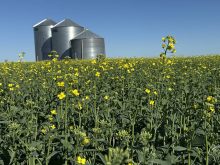Fed cattle prices rise
Fed cattle prices were $2 per hundredweight higher on steers and $2.80 higher on heifers last week, said Canfax.
Volumes were up three percent from the week before at 21,700 head.
More cattle may have been enticed into the set-aside program due to a narrower basis of -$22 instead of $25.
Slaughter last week was down because of the Remembrance Day holiday.
Alberta prices Nov. 11 were steers $77-$78.25 per cwt., flat rail $130.50-$131 and heifers $77-$78.25, flat rail $131.
Prices in the United States rose $3, causing the Alberta cash basis to widen back out to -$23.50, compared to -$20 or less the week before.
Read Also

Huge Black Sea flax crop to provide stiff competition
Russia and Kazakhstan harvested huge flax crops and will be providing stiff competition in China and the EU.
It appears -$20 will be a difficult level to move through, Canfax said.
Cattle numbers do not appear burdensome over the next 30 days but kill levels will be a critical part of the supply scenario. Dropping a few Saturday kills would mean a 15-20 percent decline in slaughter.
Producers should watch spot basis levels and make their selling decisions accordingly, Canfax said.
Beef backs up
Canadian cut-out prices fell $7 per cwt. Packers reported difficulty in moving beef products.
The higher Canadian dollar also helped to pressure prices lower.
Several plants are not slaughtering on Saturday, citing plant maintenance and the need for labour to take a break. The smaller slaughter might help reduce the oversupply of beef.
U.S. Choice light cutouts gained $1.50 US and Select rose 65 cents.
The Calgary wholesale for this week is down $2-$3 in a range of $133-$139 per cwt.
Feeder averages rise
Smaller volumes coupled with steady optimism resulted in stronger feeder cattle price averages. Sales were mixed depending on location.
Alberta auction market volumes were down 22 percent with slightly more than 74,000 head trading.
Steers 300-700 lb. were $1.75-$2.25 per cwt. higher, while 700-800 lb. were up $1. Steers 800-900 lb. were steady to 25 cents higher, but 900 lb. and heavier were down 75 cents.
Heifers 300-600 lb. were up $2-$3.25 and 600-700 lb. were $1.25 higher.
Heifers 700-900 lb. were steady to 50 cents higher, but 900 lb. and heavier were 25 cents lower.
D1, 2 cows were $1.25 per cwt. lower and butcher bulls were down 75 cents.
Canfax expects wide ranges in feeder cattle prices to continue because of quality issues and varying buyer interest.
Volumes may start to slow as producers choose to keep calves at home for the set-aside or retain ownership in the hope of better news regarding the border, Canfax said.
Stock bred cows in all areas of Alberta ranged between $250-$500 for poor quality, $500-$800 on medium quality and $800-$1,020 on excellent quality.
Bred heifers in northern Alberta were $350-$900, and in southern Alberta were $700-$1,310.
Cow-calf pairs in northern Alberta were $420-$835.
Cattle on feed
The Nov. 1 Alberta and Saskatchewan cattle on feed report showed nine percent more head on feed than at the same time last year.
October placements were larger by 21 percent, particularly on calves. The largest increase was in the 600-699 lb. class, which saw placements more than double the total of last year.
The number of calves sold at auction and through private placements increased due to snow across many parts of the Prairies that forced producers to wean and make marketing decisions during October.
Cattle coming off grass in the over 800 lb. class fell 20 percent from last year. Not as many calves were turned out to grass last spring and those that were appeared to be pulled off and sold earlier than last year.
Marketings increased in October.
The Canfax survey group, including finishing lots over 1,000 head capacity, marketed 149,222 head, up 10 percent from the same time last year.
Actual marketings in Alberta and Saskatchewan of steers and heifers were 202,007 head in October, up 11 percent from October 2003.
Hog prices rise
The weekly average Iowa-Minnesota daily direct hog price (Thursday to Thursday, 51-52 percent lean carcass converted to live weight) rose to $58.82 US per cwt. on Nov. 11. Chicago Mercantile Exchange lean hog futures December contract prices rose, setting life-of-contract records in the December through July contracts, with only May and July failing to close above $70, said Manitoba Agriculture.
A producer selling equal numbers of hogs in the eight contracts that cover the next 12 months would receive an average futures price of $69.19 per cwt. carcass or $51.89 per cwt. live, according to American analysts Steve Meyer and Len Steiner.
Iowa State University estimates break-even costs for pigs sold by Iowa farrow-to-finish operations in September to be $43.17 live. Should those costs hold over the next year, the current futures market implies average profits of $20-$25 per head. Production costs, though, will decline over the next few months as feed costs fall due to huge corn and soybean crops.
Manitoba’s slaughter plants killed another record number of hogs at 91,432 head. Last year 90,276 head were killed.
Sheep steady
Ontario Stockyards reported 3,198 sheep and lambs and 374 goats sold. All classes of sheep, lambs and goats saw steady prices.
















